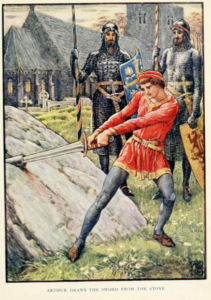Performing Gender and Genre in Miles Franklin's My Career Goes Bung
Barbara Schmidt-Haberkamp
Published in Connotations Vol. 9.3 (1999/2000)
Gender and genre are issues at the heart of both My Brilliant Career and its sequel My Career Goes Bung: both novels chronicle their heroines' rebellion against "prescribed femaleness" (Bung 447)1) and contest the gendering of genre by calling into question the distinction between supposedly superior Australian 'masculine' realism and imported British 'feminine' romance. In his article "My Career Goes Bung: Genre−Parody, Australianness and Anglophilia," Sanjay Sircar discusses the tension between realism and stylization in Miles Franklin's novel, with particular regard to genre−parody of cheap English serialized formula fiction as represented by the Penny Post novel, and he analyses the way in which they correspond to "the tensions between literary and social Australian [sic] and anglophilia" (200). While Sircar draws attention to the continual slippages between the two modes of writing, it seems to me that he retains the distinction between realism and stylization, as well as the distinction between "naive narrated self" and "the more aware narrating self" (185). This essentialism results in repeated insecurity about which passages are actually authorially and⁄or narratorially conscious or unconscious (175, 187, 191, 194, 196, 197), and leads Sircar to conclude that Bung's "parodic retention of its English prototype's traces may signal the unconscious continuation of that prototype's power" (200).
Rather than attribute unconscious slippages to either author, narrator or heroine, I would like to show that Bung programmatically sets out to parody prescribed literary discourse by marking the frequently cited laws [→page 290] of gender⁄genre identity not as being essential but as the result of a deliberate choice of social roles to enact and literary modes to employ. In other words, they are not "natural," as the male characters would repeatedly have it (310, 326, 362, 441), or representative of "God's will," as the female characters, above all Sybylla's mother, believe (270), but performative. In a recent article on Bung's prequel, My Brilliant Career, Ian Henderson, with reference to Judith Butler's widely discussed theory of gender as performance,2) has pointed out that through a complex weaving of realist and romance structures, Sybylla I's narrative "offers a model of identity based not on a single gender⁄genre identity, but on a process of performing gendered genre roles in a manner that never quite matches the ruling prescriptions." Sybylla, he maintains, "delivers a self−conscious performance of her displacement in either gendered mode, preferring to role−play.3) This process of displacing gender and genre by staging both can be shown to determine the narrative of Sybylla II as well, with respect to heroine, narrator and author.
Although My Career Goes Bung was not published until 1946, a first draft of the novel was conceived as early as 1902, one year, that is, after the publication of My Brilliant Career.4) Like Sybylla I, Sybylla II is a consummate actress. On leaving school, she realizes with a shock that "WOMANLINESS was to be our stock−in−trade," and straightaway voices her contempt for "the cunning girls who found no trouble with their role" (Bung 270). Yet in her encounters with men, and especially with her suitors, she continually role−plays, resisting—and complying with—the conventions of gender. While she simply hides from repulsive Old Grayling in a pig−sty, on her first encounter with Harold Beecham she tries to make at least her outward appearance agreeable to him, anticipating his view of her ("I did up my hair in order to look grown−up in readiness to meet him"; "I hoped he would not miss my complexion, which is one of my unassailable points," 318), and for the rest of this encounter she hides behind her housework. Women's concept of themselves as the Other, their consciousness of the way in which men view them, which is highlighted in these scenes,5) is, of course, closely linked to the problematic status of the woman writer in a male−dominated society, in which "a woman with brains" is considered [→page 291] a "monstrosity" and in which the woman writer is compared to a "performing bear," only that "the bear's performance would be more natural" (362). Sybylla is advised to "leave scribbling to men or to those women who couldn't catch a man" (366), so that despite all her defiance she comes to see herself as "a girl so unsexed as to write books" (414).
Play−acting becomes even more prominent when Sybylla enters the Sydney "SOCIETY scene" (390) where everybody seems to play "games" (406). Not unlike the grand entries of Edmée, who "adopts the public persona of innocent Post heroine" (Sircar 189), Sybylla refrains from enlightening Big Checks as to her true identity ("I could talk his pidgin while thinking about something else," 362). The best examples, however, are the meetings of Sybylla and Goring Hardy, "one of the most successful playwrights of the day" and "a social lion" (384), with whom she eventually plays "the most magic game known" (407). Again, just before their first encounter, she looks at her reflection in a mirror—"like a doll in the white dress and Gad's big sash" (388)—, anticipating his appraisal and debating with herself which role to adopt. Reflecting that "a man who had sipped deeply of forbidden women would like thoroughly untried soil," she sits down "primly in the full bloom of conventional innocence and [waits] for him to play first" (388)—successfully so, as a later exclamation of Hardy's confirms: "Such innocence! Such inconceivable innocence!" (410). In the ensuing conversation her answers or comments are "breathed ecstatically" (388), she rebukes him, and answers "staunchly" or "like a child" (389). Two meetings later, Sybylla again "[dives] into [her] rôle of girly−girly bushkin from Possum Gully" (399), and if occasion demands gazes at him "in an owl−like fashion, which I suddenly found most effective" (400). Role−playing is continued in their final encounters, in a chapter entitled "A Game for Two," in which Sybylla sees herself as "a scientist with her first case, terrifically interested and as clear−headed as a cucumber" (404)—again looking mousy (405), gurgling inwardly (409) or taking refuge in "recipes" of behaviour: "If a young woman in her teens wishes to pile on innocence one of the surest recipes is to murmur something about MOTHER." (412, cf. 413). Sybylla's performance of gender accords with Judith Butler's model of subversion: "Performativity," Butler has pointed out, "is a matter of [→page 292] reiterating or repeating the norms by which one is constituted,"6) and its subversive potential lies in the ways in which the parodic 'quoting' of gender binaries can work to decentre defining discourses.
That masculinity, too, is a matter of performance becomes clearest in Goring Hardy's role−playing, despite all his "unalloyed maleness" (388). He is interested in and amused by Sybylla "whom he estimated as without the defence of social savoir faire" (389), but when Edmée enters the room, he "instantaneously changed into a different man" (389), making "orthodox remarks with orthodox politeness" (390). On one occasion he assumes "his public shell towards [Sybylla], which was brisk and ignoring" (398), and the next moment he "[acts] like a boy leaving school" (399). In the Houses of Parliament, "Hardy acted as though I were a child he was indulging" (401), while in private he adopts the role of stern literary instructor and at the same time offers her "pretty things" in order to render her appearance more seductive. Goring Hardy's performance of masculinity is reflected in his performance as a writer: a native of Australia and one of its "great literary men," he had moved to London, we learn, where he "quickly renounced all Australian crudities" and "played the game along London lines," writing successful comedies about "duchesses and high ladies who knew all about extracting the erotic excitement from amour" (385). Interestingly enough, he replicates in his plays the stock roles and formulaic plot which, according to the genre⁄gender binaries displayed in the novel, would be associated with "feminine" romance and therefore more appropriate to a woman writer.
On the level of narration, this displacement of the borderlines of gender and genre is continued by a deliberate choice and fusion of romantic and realist modes. Sanjay Sircar has provided a detailed analysis of the parodic employment of the romantic mode, especially of the model of the Penny Post novel, with regard to plot, character and code−switching, which is rejected in Bung as a valid model yet permeates the purportedly realist "yarn" offered. At the same time, realism is devalued as a newer, better, genuine Australian mode of writing, most obviously in those passages in which the narrator comments on the public misunderstanding that "an autobiography was a device for disseminating personal facts straight from [→page 293] the horse's mouth" (279) or rejects the identification of real people with characters from her first, also supposedly realist, novel, My Brilliant Career: "The book is not real. The girl is only make−believe, and Harold Beecham a figment of imagination" (335)—a reaction, of course, to the reception of Career as pure, factual autobiography. The attempt at "Realistic Australianism" is eventually called a defeat (438), and the novel closes with dreams of an idyllic rural England complete with brooks and ivied towers, whose images are derived from "song and story" (448). Significantly, the final lines are devoted to the depiction of a sunset in Australia, which in the Preface to My Brilliant Career had been rejected as romantic "trash" (Career 2) inappropriate to a "real yarn" (Career 1)—also in sharp contrast to the many sunsets actually described in Career. I do not agree with Sanjay Sircar's view, though, that the slippages between Bung's nominal adherence to realism and its actual stylization are narratorially unconscious, and that therefore both author and narrator disingenuously claim the realism of Career to be tongue−in−cheek (Sircar 191). To my mind, the slippages serve instead to highlight the explosion of the conventions of both the romantic and the realist modes, calling into question the existence or mere possibility of a unified genre in the same way that the existence of a 'core' gender is debunked through the characters' role−playing. Sybylla II, like Sybylla I, is thus positioned outside the gendered debate of appropriate national literary expression—quite unlike Tom Collins, the narrator of Joseph Furphy's Australian classic Such is Life of 1903, who also claims to write his autobiography in opposition to custom and literary propriety, to present no more than a yarn, yet no less than "a fair picture of life,"7) and who admits to having "a peculiar defect—which I scarcely like to call an oversight in mental construction—[which] shuts me out from the flowery pathway of the romancer" (1−2; cf. 64−65, 163). While Furphy's narrator places himself firmly in the Australian masculine realist tradition, Franklin's heroines pose as "splendidly isolated literary outsider[s].8)"
This leaves us with the author herself, who, because of the handicaps involved in being a female writer, also took to a life of role−playing. "Women must conform to the well−established masculine patterns," Miles Franklin wrote at some time in the 1920s, "Otherwise they must write for [→page 294] their own recreation."9) Her realization of the patriarchal nature of the literary world and the awareness of the social mores of the time are reflected in the use of her fourth name, Miles, with its masculine aura. About the time My Brilliant Career was to be published, she wrote in a letter to her agent: "Please on no account allow 'Miss' to pre−fix my name on the title page as I do not want it to be known that I am a young girl but wish to pose as a bald−headed seer of the privileged sex."10) She was immediately found out, though, and the reception of her first novel left her without doubt about the existence of a double critical standard that categorized and criticized a piece of writing by the sex of its author. This, as well as the knowledge that female experience was often undervalued or, worse, ignored, made her, like Sybylla II, adopt "a carefully guarded" nom de plume (Bung, 446), Brent of Bin Bin, besides a number of others. Valerie Kent has presented an impressive record of the double literary life Miles Franklin created, juggled and sustained, also pointing out "the sheer cheek that often accompanied it"11)—and all this in order "to succeed and survive as an Australian writer"12) in the early decades of the twentieth century.
Universität Leipzig
































 Ring out, wild bells, to the wild sky,
Ring out, wild bells, to the wild sky,